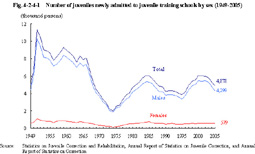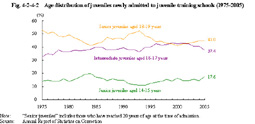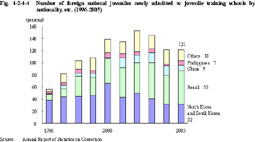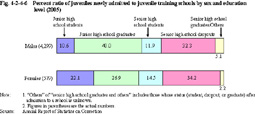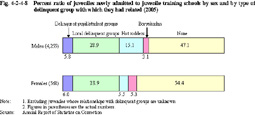| Previous Next Index Image Index Year Selection | |
|
|
1 Juveniles newly admitted to juvenile training schools (1) Number of juveniles newly admitted to juvenile training schools Fig. 4-2-4-1 shows the number of juveniles newly admitted to juvenile training schools by sex since 1949.
The number of newly admitted juveniles increased sharply in the 1950s due to the postwar chaos of the society and economy, generally remaining in the range of 8,000 to 12,000, but continued declining after that to hit the bottom at 1,969 in 1974. However, the number started to increase again and has been around 4,000 to 5,000 in recent years (See Appendix 4-12). Fig. 4-2-4-1 Number of juveniles newly admitted to juvenile training schools by sex (1949-2005) (2) Characteristics of juveniles newly admitted to juvenile training schools a. Age Fig. 4-2-4-2 shows the age distribution of juveniles newly admitted to juvenile training schools since 1975.
Fig. 4-2-4-2 Age distribution of juveniles newly admitted to juvenile training schools (1975-2005) b. Type of delinquency Fig. 4-2-4-3 shows the percent ratio of delinquency type committed by juveniles newly admitted to juvenile training schools in 2005 by sex and age group.
Fig. 4-2-4-3 Percent ratio of delinquency type committed by juveniles newly admitted to juvenile training schools by sex and age (2005) c. Nationality, etc. Fig. 4-2-4-4 shows the number of foreign national juveniles newly admitted to juvenile training schools by nationality, etc. since 1996.
Fig. 4-2-4-4 Number of foreign national juveniles newly admitted to juvenile training schools by nationality, etc. (1996-2005) d. History of protective measures Fig. 4-2-4-5 shows the percent ratio of the history of protective measures of juveniles newly admitted to training schools in 2005 by sex.
Fig. 4-2-4-5 Percent ratio of the history of protective measures of newly admitted juveniles in training schools by sex (2005) e. Education level Fig. 4-2-4-6 shows the percent ratio of juveniles newly admitted to juvenile training schools in 2005 by education level and by sex.
Fig. 4-2-4-6 Percent ratio of juveniles newly admitted to juvenile training schools by sex and education level (2005) f. Status of education or employment Fig. 4-2-4-7 shows the percent ratio of juveniles newly admitted to juvenile training schools in 2005 by status of education or employment and by sex.
Fig. 4-2-4-7 Percent ratio of juveniles newly admitted to juvenile training schools by status of education/employment and by sex (2005) g. Relationship with delinquent groups Fig. 4-2-4-8 shows the percent ratio of juveniles newly admitted to juvenile training schools in 2005 by the type of delinquent groups with which they had related and by sex.
Fig. 4-2-4-8 Percent ratio of juveniles newly admitted to juvenile training schools by sex and by type of delinquent group with which they had related (2005) h. Guardians The percentage of juveniles newly admitted to juvenile training schools whose guardians are their biological parents was 42.2% (43.0% for males and 35.9% for females), down by nearly three points in total compared to the previous year (Source: Annual Report of Statistics on Correction).
|
